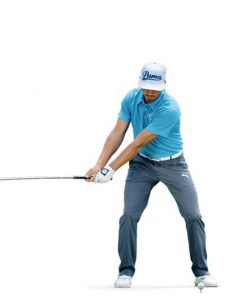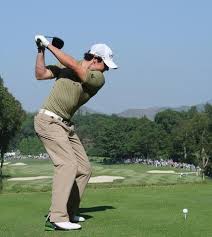Earlier this year I released a Swing Tip highlighting the most important tips that I learned at the Forum Stage in the PGA Merchandise Show January 2017. One of those tips has made all the difference in my game so I felt that I should highlight the way to cheat your body and mind to create weight shift.
Yes, I said cheat, because none of the pros need or want to do this. They all learned the proper way to incorporate weight shift from their trialing foot to their leading foot as a natural part of their swing. I see too many recreational players who panic in the middle of their backswing. Their practice swing (at 70% of their normal speed) has a perfect transfer of weight to their leading foot. That speed allows them to finish in a balanced pose on their leading foot. The problem happens when they setup to hit that little white ball.

PGA Forum Stage at Orlando Merchandise Show 2017 with Larry Rinker on the right end of the stage (not the legs on the left).
At the PGA Forum I took notes from a panel of the top trainers in USA. Hank Haney, David Leadbetter, Jim McLean, Michael Breed and Larry Rinker were all on the panel. I had never heard of Larry Rinker but he is the only one who provided a gutsy recommendation for the recreational golfer who really has a problem with timing the weight shift during their swing.
I said that Larry made a gutsy tip because it really is not ideal to start your drives and fairway shots with 60% of your weight on your leading foot according to most golf trainers. No-one refuted Larry’s comments so I have been using his tip when I find that my boding is not in sync with my game. In other words, when I start rushing my swing and topping the ball as I swing without shifting my weight to my leading foot.
I don’t know why this problem sometimes starts at the first tee or half way through my round but my mind just has a brain cramp where I lose the fluid motion of my swing. I just start swinging with my arms and forget to create the shift of my hip forward (for weight transfer) during the transition at the top of my swing. I end up with most of my weight still on my trailing leg at the point of impact.
THE TIP:
Larry Rinker suggested that recreational golfer have a problem transferring their weight to their leading foot during the downswing. He suggested setting up with 60% of your weight on your leading foot and holding your weight forward throughout your backswing and downswing so that you will finish with all of your weight on your leading foot. [Just bend your leading knee a little more to tilt your body forward exactly the way you want it as you lean into your shot at impact.]
When your body and mind are relaxed (like the Pros who play with their mind IN THE ZONE) your rhythm will take care of the weight transfer. But it’s difficult to stay relaxed when the pressure is on for a perfect shot. Eventually you will learn to make the weight shift a natural part of your swing. It feels wonderful to finish your swing in balance on your leading foot and watching your ball land where you planned to have it land.
I can’t give all the credit for this tip to Larry Rinker as I first heard this tip when I met Andy Schwabe in the Blue Martini in Naples, FL. (He just happened to be one of the first 100 golfers who had purchased a GOLFSTR ). He showed me the same tip about 4 years ago. Pros warn against too much pressure on your leading foot during your setup as you can lose power and direction control. So don’t put too much pressure on your leading foot to ensure that you get plenty of distance and consistent, straight drives and fairway shots.
Setup with 60% of your pressure on your leading foot and practice with a straight leading arm for more consistent, longer hits. Practice with GOLFSTR+ and buy one today at www.golfstr.com




